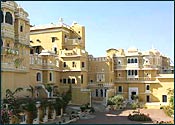|
|
|
|
|
|
|
|
|
| Deogarh Introduction |
|
 Deogarh is situated on the right bank of the river Betwa at a distance of 123 Kms. from Jhansi at the western end of the Lalitpur range of hills. Distance of Deogarh from Lalitpur is 33 Kms. The chief of Deogarh, known as 'The Rawat' was one of sixteen umraos (feudal barons) entitled to wait upon the Maharana of Udaipur, the capital of Mewar. These type of feudal estates, called 'Thikanas' were sanctioned by the ruling Maharana to a nobleman either due to blood relationship or for an act of valour. Deogarh is also famous as a school of miniature painting. Deogarh is situated on the right bank of the river Betwa at a distance of 123 Kms. from Jhansi at the western end of the Lalitpur range of hills. Distance of Deogarh from Lalitpur is 33 Kms. The chief of Deogarh, known as 'The Rawat' was one of sixteen umraos (feudal barons) entitled to wait upon the Maharana of Udaipur, the capital of Mewar. These type of feudal estates, called 'Thikanas' were sanctioned by the ruling Maharana to a nobleman either due to blood relationship or for an act of valour. Deogarh is also famous as a school of miniature painting.
We at StayResIndia.com , a leading inbound tour operator in India , promote tourism in Deogarh and can book hotels and resorts in Deogarh as per your budget. We maintain very good professional relationship with all the major hotel chains and independent properties in India including Deogarh . It helps us in offering you competitive hotel and resorts tariffs in Deogarh.
|
|
|
|
|
Top ˆ |
| Tourist Attractions in Deogarh |
|
|
| § Deogarh Mahal |
|
Deogarh Mahal is an imposing structure built in the 17th century. It stands atop a hill and offers a commanding view of the Aravalli mountain range and the numerous lakes, strewn across the countryside. With its old battlements, domes, turrets, jharokhas and huge gateways, it is a picturesque sight from the town below Deogarh Mahal was converted into a hotel about 3 years ago, by the present owner Rawal-Nahar Singh. A part of the Mahal is still occupied by his kin.
|
|
|
| § Dashavatar Temple |
|
The exquisite Vishnu temple at Deogarh belonging to the Gupta period, popularly known as the Dashavatar Temple is the earliest known Panchayatan temple of north India . The terraced basement above the high temple plinth is decorated with an uninterrupted row of sculptured panels.
|
|
|
| § Manastambha |
|
The group of 31 Jain Temples, though of a later date, are no less notable. The site was a Jain centre from the post-Gupta times upto the 17th century. Panels reflecting scenes from Jain mythology, Tirthankara images, a Manastambha (votive pillar), Ayagpatta, Sarvato bhadra pratima and Sahastrakuta are found here.
|
|
|
|
|
Top ˆ |
|
|
|
|











